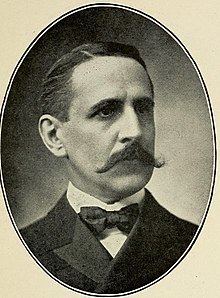Preceded by William H. Harries Children 5 Succeeded by Sydney Anderson Spouse(s) Emma B. Newall Party Republican Party | Political party Republican Role Politician Preceded by Position Established Name James Tawney | |
 | ||
Full Name James Albertus Tawney Alma mater University of Wisconsin–Madison Died June 12, 1919, Excelsior Springs, Missouri, United States Education University of Wisconsin-Madison | ||
James Albertus Tawney (January 3, 1855 – June 12, 1919) was an American blacksmith, machinist and U.S. politician and a member of the United States House of Representatives from Minnesota. He was the first House Majority Whip, holding that position from 1899 to 1905.
Contents

Early life

Tawney was born in Mount Pleasant Township, near Gettysburg, Adams County, Pennsylvania. He apprenticed with his father as a blacksmith, and subsequently learned the trade of machinist. In 1877, he moved to Winona, Minnesota, where he was employed as a blacksmith and machinist until 1881. He attended the law department of the University of Wisconsin–Madison, and was admitted to the bar in 1882 and commenced practice in Winona.
Political career
Tawney was elected to the Minnesota Senate in 1890. In 1892, he was elected to Congress as a Republican, and served in the 53rd, 54th, 55th, 56th, 57th, 58th, 59th, 60th, and 61st congresses. During his time in Congress, Tawney served as Majority Whip and as chairman of the House Committee on Appropriations.
In 1910 he was defeated incumbent in the Republican primary election by 30-year-old Sydney Anderson, who had the support of Theodore Roosevelt, Gifford Pinchot and other Progressive Republicans. Anderson ran on a platform of drastically reduced tariffs and opposition to Cannonism (with which Tawney was identified).
After Congress
Tawney was a member of the International Joint Commission (created to prevent disputes regarding the use of Boundary Waters between the United States and Canada) from 1911 until his death, serving as chairman of the United States section from September 17, 1911, to December 1, 1914.
Tawney died at Excelsior Springs, Clay County, Missouri.
